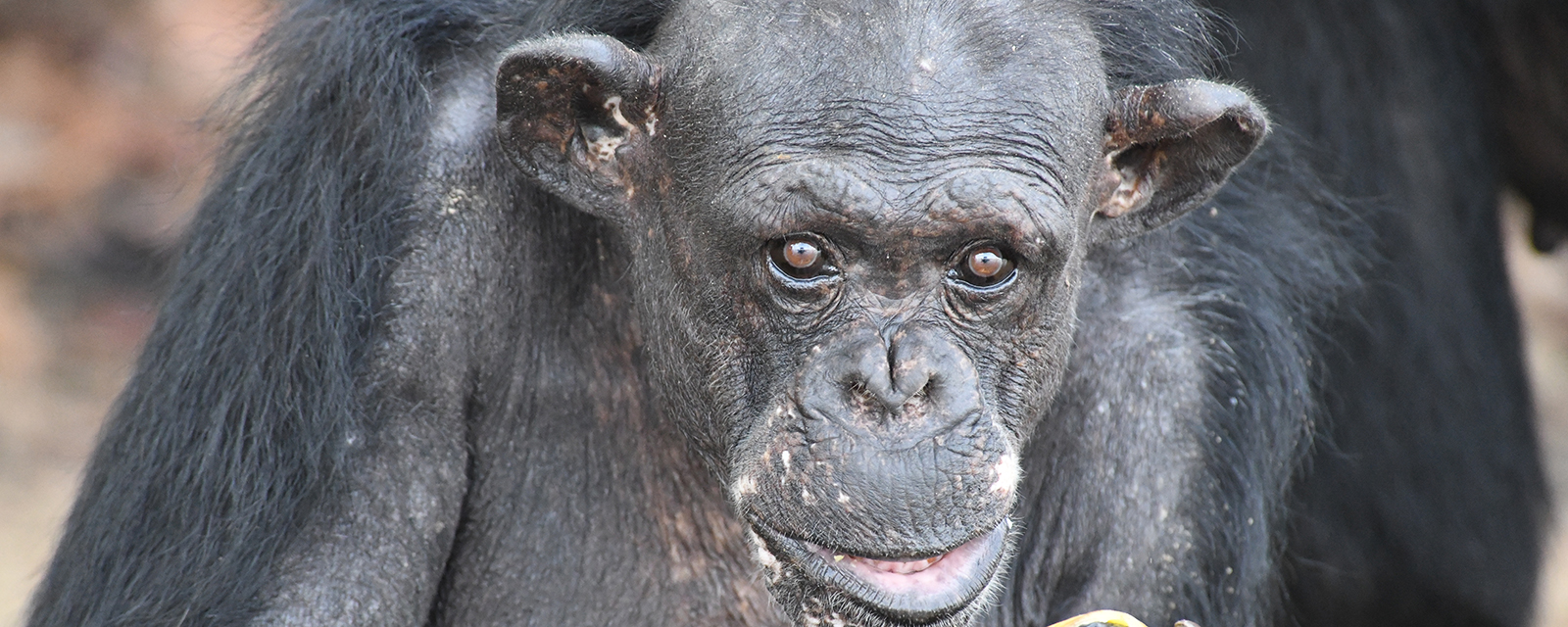By Sara Amundson and Kitty Block
Samantha was a little over a year old in 1976 when her world changed forever: The tiny chimpanzee was sold to a laboratory in Liberia by a resident of a nearby village. Like many of the other chimps at the lab, her parents had probably been killed by poachers so that Samantha could be sold. At the lab, researchers immediately began using Samantha in experiments.
Samantha, who now lives at Second Chance Chimpanzee Refuge, our sanctuary in Liberia, spent the next 25 years being subjected to invasive procedures and experiments. She learned to cope by becoming an expert escape artist. She would spend a good portion of each day figuring out new ways to escape by working away at wires or finding loose rocks to open the lock on her cage. The staff always knew when she had finally broken out, because all the chimps in the lab began to scream and yell. She never went far; instead, she would go cage to cage visiting the other chimps until she was tranquilized and returned to her cage.
After many years of escaping her cage, it was determined that she should be moved to the lab’s breeding colony, which was more secure. There, Samantha gave birth to three babies, but she never had a chance to raise them. The first two were taken from her to be raised by the staff. The staff did not have adequate knowledge to care for newborn chimpanzees and both babies died soon after. Samantha’s third baby also died, this one from unknown causes. But Samantha has persevered by directing her strong maternal instinct toward acting as a guardian for other young chimpanzees she encountered over the years.
In the early 2000s, the lab began phasing out its research on chimpanzees and moving the chimps to nearby islands. When Samantha was released from the holding cage onto Island 5, her new home, she was extremely excited and immediately ran into the forest with the rest of the island’s chimps right behind her. At first, Samantha and the other chimps hid in the forest and did not come to the shoreline to eat food brought by the caretakers. Instead, they subsisted on the small amounts of fruits, berries and leaves they found. Finally, after a few months, they realized that they could safely eat the food without being captured and slowly began to come to the shoreline when the caregivers arrived.
Then, in 2015, the organization that ran the laboratory pulled out of Liberia, leaving the chimpanzees with little access to food or fresh water. We stepped in to provide emergency care to the chimps, and since then, we have committed to the lifelong care of the more than 60 chimpanzees on the five islands. Despite their heartbreaking past, these chimpanzees are resilient animals who have finally been given the peace and safety they deserve.
Today, Samantha is enjoying life as the eldest resident of the sanctuary and one of the dominant females on Island 5, where she enjoys her favorite foods of pineapple and rice balls. It’s our honor that we can give Samantha and the more than 60 other chimps at Second Chance the safety, security and independence they deserve. And our work to protect chimpanzees does not stop there.
For decades we have fought to end the suffering of chimpanzees in labs. In 2000, we worked alongside a coalition of animal protections organizations to secure passage of the CHIMP Act, which created a federal sanctuary system for chimpanzees used in experiments. We then turned our focus to ending harmful experiments on chimpanzees—and in 2015 our petition to grant captive chimpanzees—including chimps in labs—the same protections that wild chimps had under the Endangered Species Act was successful. At the time, the U.S. was the only country that still used chimps in experiments. Now that they have protections, it is highly unlikely that chimps will ever be used in harmful research again.
Even after our successful campaign to end biomedical research on chimpanzees in the U.S., we did not stop fighting for chimps. Since then, we worked to ensure that chimps who were used in experiments. get the sanctuary life they deserve. We are also fighting in court to compel the National Institutes of Health to transfer government-owned chimpanzees who continue to languish in labs to the chimpanzee sanctuary, Chimp Haven. Chimps like Samantha deserve the best lives possible after all they’ve been through.
Kitty Block is CEO of the Humane Society of the United States
